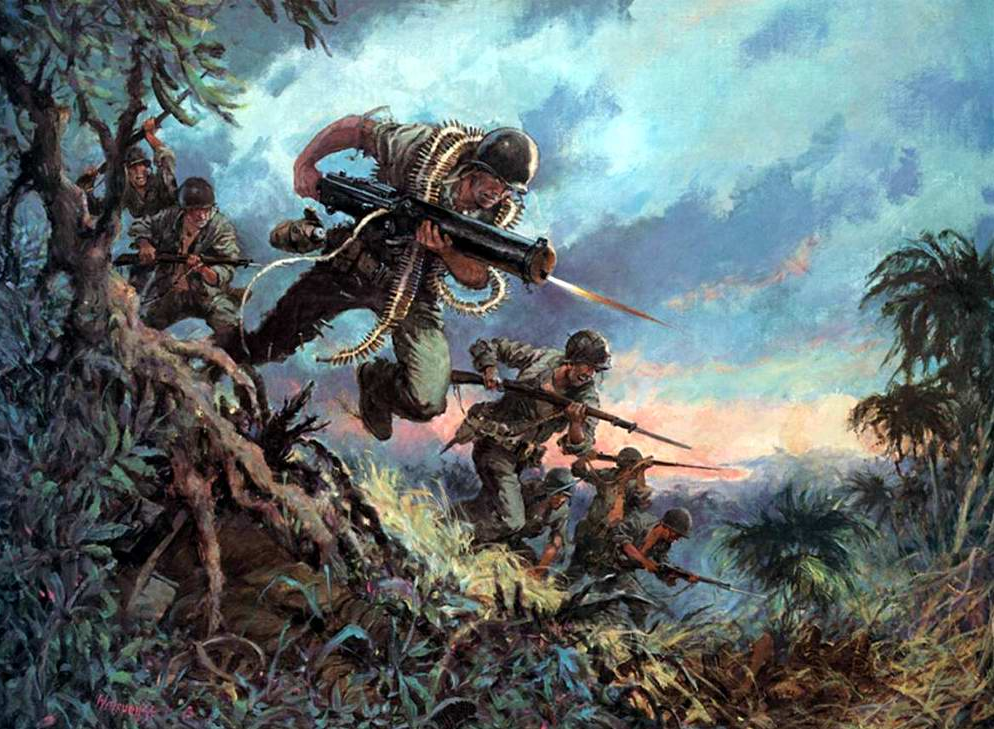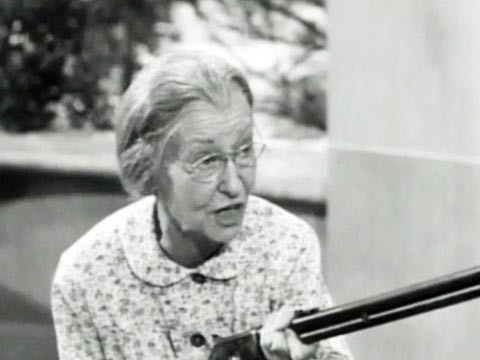Editor’s note: The following comprises Chapter 13 of Children of Yesterday, by Jan Valtin (published 1946).
(Continued from Chapter 12: Children of Yesterday)
________________________________________________________________________
“The terrain is the toughest I ever saw.”
Major General F. A. Irving, Commanding the Twenty-Fourth Infantry Division on Breakneck Ridge
________________________________________________________________________
The Japanese bastions on Breakneck Ridge were broken and overrun in seven days of continuous assault. The battle lines did not move forward in a solid front. They moved like the spread fingers of a thrusting hand. The frontal assault was borne by the Twenty-First Infantry Regiment. Battalions of the Nineteenth and Thirty-Fourth hacked away at the flanks and the rear of the enemy lines. The offensive was fought by battle-weary troops, over precipitous ridges, in jungle, mud and constant rain.
A single mortar platoon commanded by Lieutenant William Langford of Valdosta, Georgia, fired 7,200 rounds of mortar ammunition in support of infantry charges in seven days. And every shell fired had to be carried up Breakneck Ridge on soldiers’ backs.
Sergeant John T. Kennedy of Pawtucket, Rhode Island, led his rifle squad in a charge on one of the contested ridges. Upon gaining the crest, a Jap machine gun fired from a cave. Kennedy crawled forward through clumps of grass intent on destroying the Jap gunners. He was wounded, along with other men of his squad. Japs swarmed from hidden spider-holes. John Kennedy’s squad faced annihilation.
“I’ll hold ’em,” the wounded sergeant shouted to his men. “Get back and dig in. Get the wounded out o’ here.”
The squad fell back to a stretch of ground which allowed for a better defense. Half of the fit dug holes in the slush, and the other half rescued the wounded. All but Kennedy. Alone, the squad leader held a platoon of Japs at bay. He fired and fired and he threw grenades. The Japs brought on mortars. They brought down a mortar barrage on the lone American. The men of the squad dug in and lived to fight another day. John Kennedy died in the burst of a mortar shell.
A Japanese hidden in a foxhole allowed an advancing platoon to pass. Then, after machine gun fire from the front had stopped the platoon, the Jap rose and hurled a grenade at the officer commanding the platoon. The officer fell. A rifleman, Ralph Frantz of Frackville, Pennsylvania, brought his rifle to the shoulder and fired. There was a click; the rifle failed to fire. The Jap reached for another grenade. Ralph jumped into the foxhole and slew the Jap with his hands.
A company pinned down on a hilltop by a checkerboard of machine gun nests called for artillery support. An artillery observer named Christ Frangos came forward. Almost immediately his radio was shot from his hands. Frangos crawled down the slope and laid a telephone wire to a point less than fifty yards from the Japanese positions. He maintained the wire line for forty-five minutes. In this time field artillery cleared the terrain to make possible a continuation of the advance. The mission was a success. But Christ Frangos died. His home was in Ames, Iowa.
A combat patrol probing ahead of the regimental advance received machine gun fire as it crossed a mountain stream. Sergeant Stephen Kupczyk of Chicago, the leader of the patrol, deployed his men along the stream bed in an effort to destroy the machine gun. Then rifle fire crackled from the flanks. Snipers. A scout of the patrol was badly wounded. Kupczyk saw the wounded boy flounder across the stream and collapse in the path of fire. The sergeant now rushed up the stream bed to save his scout. He reached his fallen comrade and was about to pick him up, and suddenly Kupczyk slumped forward. A sniper’s bullet had killed him.
The fire fight continued. Private Claud Long of Sutton, West Virginia, had fired some sixty rounds at the Japanese machine gun roost. He now went hunting for the sniper. After some cautious prowling he found him. The sniper was dug in on higher ground between two trees. He was about twenty yards away. Long brought his automatic rifle into position. He took aim and he pressed the trigger. The automatic rifle jammed. Rain and mud do things to weapons. By this time the sniper had discovered Claud Long. The West Virginian cursed his luck. He toiled to eject a ruptured cartridge from the chamber of his B.A.R. While he worked he rolled over the ground, this way and that. The sniper fired three times at Long. The shots missed him by inches. After the third shot, Long’s B.A.R. was ready again for action. He called the sniper every abusive word he could think of. Then he drilled him with twelve bullets.
Though thousands of men fought at close quarters on the slopes and in the ravines of Breakneck Ridge, the battle broke down into innumerable duels between small teams of haggard men, day and night through seven days. Take Private Herbert Jump of Covington, Kentucky. Jump was a rifleman armed with a Thompson submachine gun, and the leader of a rifle squad. The squad worked through tall grass toward the crest of a ridge. The lead scout discovered an enemy emplacement near the crest. There were four Japs and a machine gun in the emplacement. The Japs were waiting for Jump’s squad to gain the top of the ridge where each man would be silhouetted against the sky. Then the Japs would mow down the squad at close range. Jump halted his squad. He hugged the ground and he crept toward the enemy emplacement. Three yards from it he stood up and killed the Japs with a long burst from his Tommy gun. The squad dug in for the night atop the ridge.
The Japanese counter attacked immediately. They swarmed onto a thickly overgrown knob on the ridge. From this vantage point they proceeded to bombard Jump’s unit with grenades. Rifle fire against the Japs was of small avail. The enemy remained invisible, and protected by the rise in the ground, though he was no more than a stone’s throw distant. The Japanese answered each volley from the Garands with shrieking laughter and with more grenades.
“I’m going to fix those birds,” said Herbert Jump.
He wriggled down the slope and skirted the ridge. Then he crawled back to the crest of the ridge in the rear of the grenade throwers. He walked in on them without warning. His submachine gun blazed. Six of the grenadiers died. The survivors fled in panic.
The final storming of Breakneck Ridge began at 9 A.M. on November 11. It ended on November 17, when the battered assault teams fought down the southern slopes and entered the upper reaches of the Ormoc Valley near Limon. Daily progress was counted in hundreds of yards. The whole battle took place on an irregular front not more than five miles long and two miles deep. It was one of the bitterest battles of the Philippine war.
The attack was launched — two battalions abreast — from the heights captured during the previous day. One force pushed south; the other west. They gained three hundred yards in five hours of fighting. Resistance was fanatic. At noon the Japanese hurled counter attacks from commanding ground marked on the Division’s maps as “Corkscrew Ridge.” Among the weapons wielded in this collision were bush-knives and white phosphorus. Another stalemate threatened. Then — despite a report that the Japanese had heavily mined the Ormoc Trail — Colonel Verbeck called tanks into action.
The engineers watched tanks and tank-destroyers rumble across the bridge they had thrown across Dead End Gulch. But once across the bridge, the tanks stopped. Verbeck came forward. Tall, wiry, blond, the irrepressible colonel strode up the Ormoc Trail with apparent unconcern. He who had fought through World War I as an infantry private, and later with the Philippine Scouts and in Alaska, understood a soldier’s problems from the bottom up. “Damn good man to take along on a patrol,” his men said of him, and, “Never saw anybody so thin walk so straight.”
The colonel called upon the regimental Reconnaissance Platoon to protect the tanks’ advance against thrusts by suicide detachments. He also called forward a mine-detector squad to clear the road ahead of the tanks. In front of them the Ormoc Trail twisted steeply toward a saddle between two ridges. On the ridges and in emplacements flanking the saddle were the Japanese. Their machine guns chattered with callous confidence.
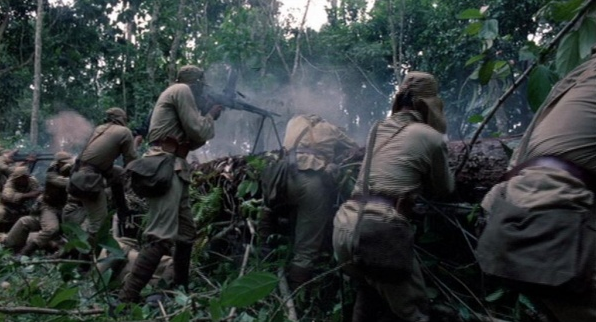
“Get going,” said Verbeck.
The going was dangerous and slow. But it was the turning point in the battle for Breakneck Ridge. On foot, leading the column with studied carelessness was Bill Verbeck. With the colonel, also on foot, was the commander of the tanks, Captain Julian van Winkle of Louisville, Kentucky. Yard after yard they guided the tanks through muddy craters, over log barricades and through heavy and continuous fire. The tanks’ guns spat over the heads of the guides. Twice Captain van Winkle was wounded in the advance; but he stayed with his tanks until the summits of Breakneck Ridge had been cleared.
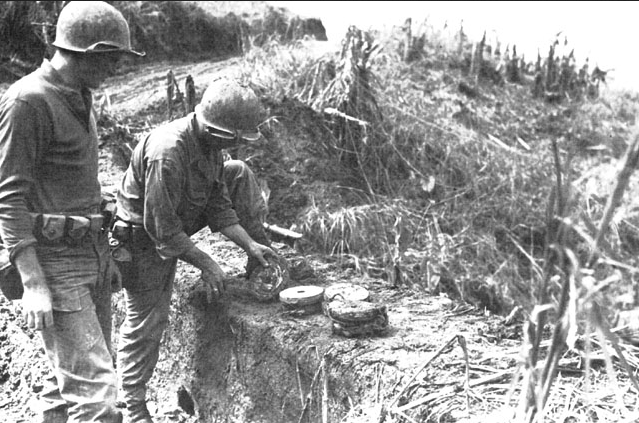
Meanwhile, the engineer group labored with mine detectors to clear the road for the tanks. They labored through the weirdest two days of their lives. The engineers would crawl forward on their stomachs and clear a three-foot stretch of road in front of the leading tank. Then the engineers would crawl aside, and the tank column advanced three feet— and stopped. After that the engineers crawled forward again under the bellies of the tanks and cleared another three-foot strip of the Ormoc Trail. And the tanks advanced another three feet.
Fighting during this operation was savage. The men of the Reconnaissance Platoon fired their weapons to burning heat to ward off Teishintei detachments intent on throwing mines under the tanks. Corpsman Harvey Perry of Burnwell, West Virginia, carried a wounded engineer down the slope and did not stop his errand even when Jap machine gun fire ripped his first aid pouches from his back. One tank crunched off the edge of the Ormoc Trail. It drowned in mud. Its crew was rescued by another tank — and ten men crowded into armored cubicles which had been built for five. Gunfire then destroyed the mired tank.
The slowness of the advance was blightening torture for the men who fought this battle. The armored column proceeded to the top of the ridge at a pace of three hundred yards a day. But the tanks’ cannon destroyed twenty-five Japanese strongpoints defending the pass across Breakneck Ridge.
Three wounded soldiers huddled in a shell hole on the crest of the ridge. They were members of a team which had gained the crest two days earlier. Their team had been thrown back by Japanese counter attacks. Two corpsmen in charge of the wounded had been killed in the withdrawal, and the wounded had been lost among the Japs. For two days they had hidden in thickets and in slime-filled holes. They had experienced the terror of a friendly artillery barrage, and of ant swarms and rats attacking their wounds. When they were discovered by infantrymen protecting the tank thrust, all three were too weak from shock and loss of blood even to speak. The men who carried these wounded to safety over a slope raked by Japanese gunfire were William Dougherty of Atlantic City; Joe Schappert of Covington, Kentucky; Frederick Etheridge of Avenal, California; and Dale Johnson of Manhattan, Kansas. Their comrades safe, the rescuers returned into the fight. Dale Johnson was killed in action.
Leading an assault platoon on another section of the ridge was a young Minnesotan, Lieutenant Evert Rennaker from Fairmont. Rennaker felt his heart would burst in the harrowing ascent. His group reached the top. The men fanned out to burn the remaining Japs from their holes. An enemy machine gun fired. The soldiers hit the mud and waited for orders. No orders came. Evert Rennaker had collapsed from exhaustion.
Two soldiers dragged their platoon commander to the nearest command post where aid men were at hand. There Rennaker regained consciousness. “What are you going to do?” he asked the corpsmen.
“You’re knocked out,” a medic said. “Doggo. We’ll ferry you to hospital.”
Something in Evert Rennaker rebelled against the idea of rest. He heard batteries of field artillery send crashing salvos toward the mountains. From the embattled heights came the breathless clatter of machine guns. Rennaker thought of his platoon fighting up there on Breakneck Ridge. He brushed the corpsmen aside and staggered out. He panted to the top of the ridge where his platoon was still embroiled with the hostile machine gun. The machine gun fired from a six-foot-deep hole dug at the mouth of a cave.
The men stared at Rennaker as if they saw a ghost. Without a word their lieutenant crawled past them. He crawled toward the machine gun nest with a mute and immense singleness of purpose. He killed the Jap gunners with a grenade. By now he was wounded and bleeding. He jumped into the hole and threw out the dead Japs, one after another.
Down the grassy hillside other Japanese were gathering for a counter assault. Rennaker heard them scream as they came on. His lips tight and his eyes shining through sweat and grime Evert Rennaker, “Item” Company, Twenty-First Infantry, swung around the captured machine gun and made it belch death into the wave of skirmishers down the slope.
In an adjoining sector, to the right of the advancing tanks, fought a rifle platoon led by Albert Wright of Little Rock, Arkansas. The platoon was stopped near the crest by machine gun fire. The fire blazed from two spider-holes fifty yards farther to the right. The holes, dug in the shape of upright, thin-necked, thick-bodied bottles could not be reached by the fire of the tanks. Wright led his platoon against the holes. There was but one way to tackle them: to climb on top of them and to destroy their occupants with grenades, dynamite or fire. Machine gun bursts mortally wounded Albert Wright before he reached the holes. But he remained on his feet until the job was done. Then he fell, and the attack continued.
To the left of the Ormoc Trail Captain James Blodgett of Toledo, Oregon, a field artillery observer, kept pace with a company of infantry in the attack. A few yards from the rim of a ravine at the base of the Corkscrew Ridge the company was halted. Hostile machine guns fired from the cover of the ravine and Americans were killed and wounded. Sudden fire from mortars up the slope increased the company’s distress. The enemy positions were too close to be pounded by artillery fire without endangering the friendly force. Captain Blodgett, his head pressed close to the ground, heard American machine guns firing some distance away. And abruptly the artillery observer cast all prudence aside and stood up. He shouted to the machine gunners:
“Hey, you guys, come over here.”
The gunners came, ducking low through the kunai. The artillery officer helped them mount their guns.
“Now,” he said. “See that ravine? See that hillside behind it? Give her all the bursts you can.”
Through the crashing of Jap mortar shells the machine guns hammered. One hundred and fifty rounds per minute per gun. The Japs pulled in their heads. The machine guns continued to fire while infantry charged the ravine. When the foremost rifle men broke out in Indian yells, Blodgett waved his hands. “That’s fine, boys,” he said. “Cease firing.”
Night came and the assault battalions dug their perimeters on the summits of Breakneck Ridge. The enemy was reinforcing. Aerial observers reported long troop columns moving north through the town of Limon. Heavy artillery concentrations denied them the use of the Ormoc Trail. But the Japs launched four counter attacks under cover of darkness. All were repulsed.
Chemical mortars rained phosphorus shells on the hillsides and gullies. In the light of the burning slopes and of flares floating from paper parachutes, the machine gunners on the perimeters played havoc with oncrawling Japanese. The conflagration, too, cleared the terrain and opened lanes of fire for the riflemen. Three hundred and fifty rounds of phosphorus and two thousand two hundred high explosive shells roared from the mouths of the mortars during that night. Then infantry again muscled forward.
Somewhere in a factory in America a worker had been careless in fitting a fuze into a mortar shell. On Breakneck Ridge the shell exploded the instant it was fired. Two Americans were killed and seventeen wounded in the premature blast. Among the wounded was Corpsman William Hull of Rock Island, Illinois. He dragged himself around the mud, tending the other wounded until he became too weak to go on.
Five soldiers worked day and night to carry mortar shells from stalled trucks on the Ormoc Trail to their mortar section emplaced on a ridge. They carried more than their own weight in shells down a muddy slope, across a jungle-filled canyon, and up the muddy side of the ridge. Each trip they were harassed by enemy snipers. They skirmished with the snipers while they carried their loads. They were but five of many others: James Huggins of Dillion, South Carolina; Chester Jankowski of Milwaukee, Wisconsin; Charles Bonton of Noroton Heights, Connecticut; Raymond Tonelli of Pawtucket, Rhode Island; and Kenneth E. Cox of Tracy, California.
A Texan, Sergeant Ray Shone, of Denison, spotted six Japanese snipers grouped around the base of an enormous lauan tree. His fighting job was that of a platoon guide, and in Shone’s Service Record there is a notation which says that his “ability to locate enemy snipers is outstanding.” The six snipers under the lauan tree had shot down an ammunition carrier. The Texan worked his way through thickets and attacked the snipers from the flank. Five of them crumpled under his marksmanship. The sixth escaped. Shone then went forward to give aid to the wounded ammunition bearer. A sniper’s rifle cracked and Sergeant Shone, too, fell in the soggy kunai.
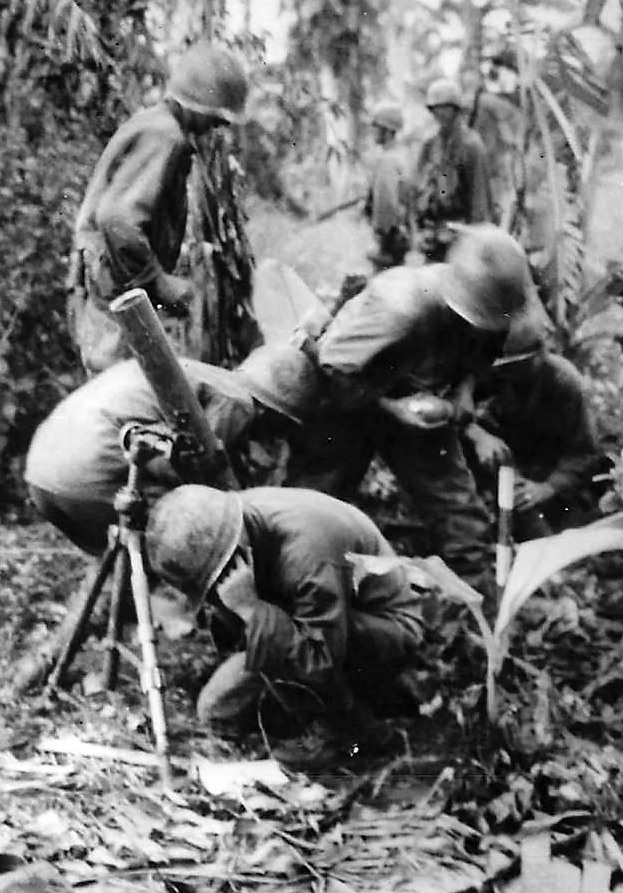
The battle for Breakneck Ridge rolled into its tenth day. The men of the Twenty-First knew that they were winning the fight. Exhaustion gave way to a resurrection of the desperate vigor of a spent swimmer who suddenly discovers the nearness of land. Sergeant William Francher of Lakeview, Texas, though badly smashed by artillery shrapnel, held out at his post to keep “King” Company’s mortars in action. At the base of Observation Hill, dog-tired John McClelland of San Mateo, California, killed six Japanese who had attacked his platoon from the rear. After ten days and nights of fighting on Arson Hill, chunky, tattooed Leroy F. Hanse crawled atop two pillboxes and killed nineteen Japanese with rifle and grenades. After one company’s telephone communications had been smashed, Private William Cheatwood of Buchanan, Georgia, ran two and one-half miles through mud, jungle, sniper and artillery fire to bring telephone wire and hand sets to his company commander.
A rifle platoon working up a gully at dusk was attacked by a company of Japanese who came rushing down the sides of the draw. The platoon fell back to evade destruction. Private Nolen Rogers of Taft, Tennessee, and Private Carl Schneeweiss of Banning, California, remained to cover the withdrawal. Rogers was armed with an automatic rifle. Schneeweiss fired a Thompson submachine gun. They held the Japs at a distance until their platoon regrouped and struck the enemy from the flank.
In the fighting for Hill 1525, Sergeant Ricardo Gallegos of Ferrell, Pennsylvania, and Private Roy Adams of Cincinnati, Ohio, blasted Jap defenders from three spider-holes and then held the positions against counter attack until relief arrived. Both were “Able” Company men. Another Adams, also from the “Able” team, dueled with three Japs in a cave, without success. Angered, he went to the rear, came forward again with a flame-thrower and tackled the foe with burning gasoline.
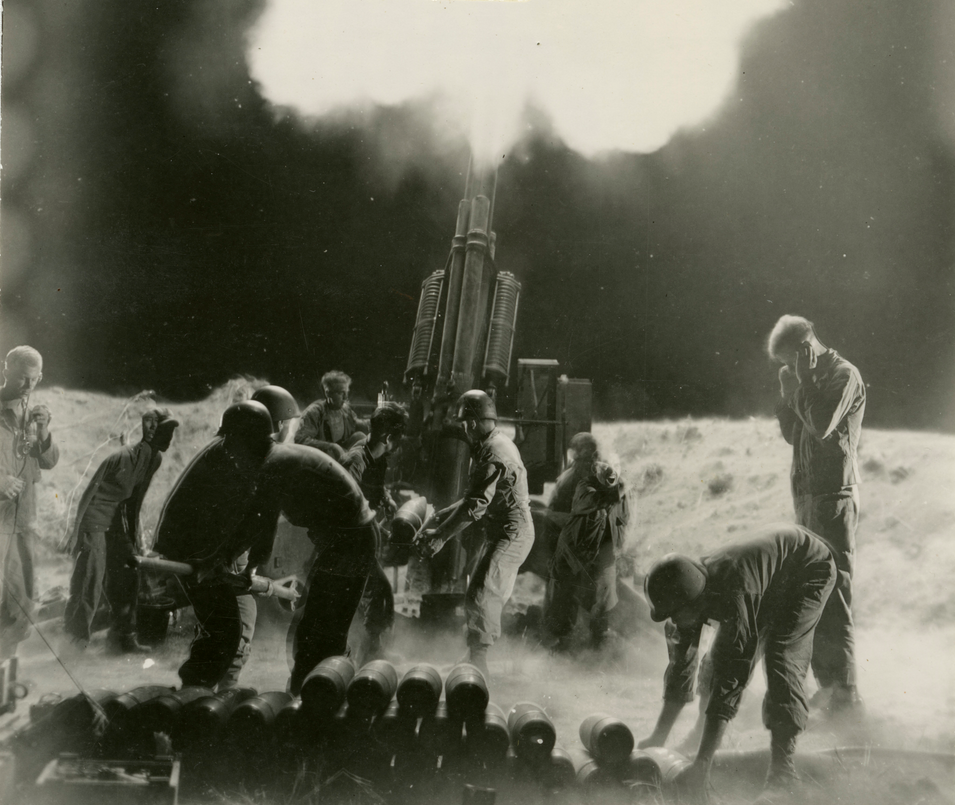
The push down the southern slopes of Breakneck Ridge began on November 13. An all-night cannonade prepared the way. The First Battalion slugged forward six hundred yards to the top of an intermediate ridge. The Second Battalion advanced four hundred yards. The Third Battalion was alerted when heavy Japanese counter thrusts struck the forward teams late in the afternoon.
On November 14 the battalions drove to within 1,200 yards of the town of Limon at the head of the Ormoc Valley. During the day and the following night they repulsed five counter attacks, the last of which ended in a bayonet fight. The Japanese spearhead had penetrated the regiment’s defenses. The Japs overran a line of mortar positions. The mortarmen were driven from their weapons. Around the foxhole which housed the battalion command post mortar crews fought their assailants with carbines and knives.
In the command post foxhole sat Captain Hugh S. Crosson. He climbed out of the hole and reassembled the scattered mortarmen. He led them back to the perimeter to defend their weapons. Rain fell in a torrential downpour. More Japs darted out of the kunai. They bore knee mortars, machine guns, grenades. They had bayonets fixed to their machine guns. In the uproar of firing and screams Captain Crosson formed a combat patrol of riflemen. He led this patrol to the flank and down the slope with the intention of striking the attackers from the rear.
Standing up in a foxhole and firing his automatic rifle at Japs all around him was Joy Berry of Wapato, Washington. Private Jack Furman of Augusta, Georgia, already twice wounded and on his way to a rest area, seized a rifle and rushed into the fight. A cook named Elon Darby, of Potomac, Illinois, risked his neck to save the critically wounded. Meanwhile, the combat patrol directed by Captain Crosson came up in the enemy rear. The Japanese who had wedged into the American position were trapped. Not one of that group came out alive.
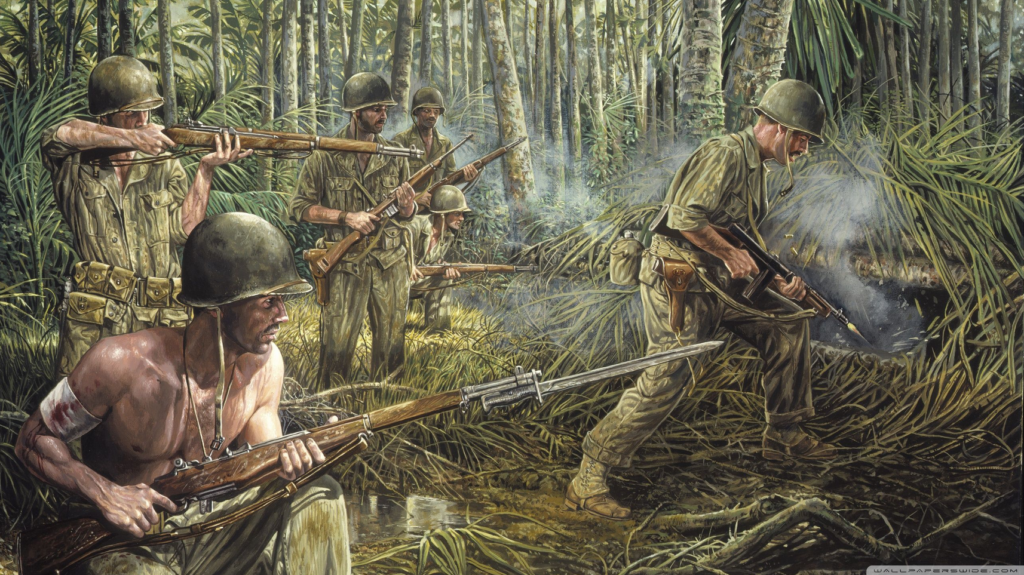
On November 15 and 16 all companies of all battalions attacked the last remaining high ground north of Limon. Engineer and reconnaissance detachments destroyed many pockets of snipers by-passed in the ravines and hollows of Breakneck Ridge.
A company of infantry was dispatched six hundred yards to the rear of Japanese defenses near Limon on a mission of dis organizing the retreat. Led by Lieutenant Theodore Crouch of Owingsville, Kentucky, the company moved out stealthily after sunset of November 15. In a forced march around hills and swamps it circled the enemy flank and dug in astride the route of Japanese withdrawal. At noon, November 16, falling back before the frontal attack, Japanese backed into Crouch’s fire. The demoralized survivors fled into the bogs of the upper Naga River.
The enemy had lost the passes over Breakneck Ridge. His main force retreated down the Ormoc Valley for a final stand. Numerous detachments, pressed away from the Ormoc Trail into the central mountains to the southeast, reorganized and massed to harass the Division’s supply lines from Carigara and the Leyte Valley. Japanese artillery manhandled into trackless mountain regions sent salvos crashing over the coastal road.
A battery of field artillery firing from positions near Colasian received more than its normal share of tribulations. There, an artillery duel, a burning powder dump and exploding stores of rifle and machine gun ammunition set the stage for a fire-fighting job which pushed the cannoneers as close to the rim of hell as any man can come and live.
Captain Victor L. Boling of Duncan, Oklahoma, was ducking low under detonations of Japanese shells. Suddenly he heard a crash louder than all others. The crash was followed by a charivari of shouts, and by lesser explosions which the captain’s trained ear identified as not from enemy shells. Sheets of yellow-red flame stabbed skyward behind a nearby row of trees. The Oklahoman abandoned shelter to investigate the commotion.
The Japanese had scored a direct hit. A pile of powder charges had been set afire. There were other stores of powder charges nearby. There were quantities of howitzer shells and of small arms ammunition. In the conflagration wounded cannoneers struggled to get away from the flames. The immediate urge of those not disabled was to run away. Shells screamed in at half-minute intervals. Since no one ran — all stayed.
Corpsman James J. Shamany of Sheppton, Pennsylvania, weaved in and out among the flames and explosions to pick up the wounded. He dragged them into an adjoining plantation and gave them morphine to ease their pain.
The battery commander, Lieutenant James H. Will, of Oklahoma City, jumped into the burning gun pit and yanked out several wounded men while enemy artillery projectiles burst twenty- five yards away. Then he organized his cannoneers to fight the fire.
Artillery Sergeant Howard Wagner of South Omaha, Nebraska, jumped aboard a bulldozer. He had never worked a bulldozer before. But he managed to set it into motion. He piloted the uncouth machine into the blaze and used its blade to push the spreading fire away from the fused 155-millimeter howitzer shells lying but a few feet off. Everyone feared that Wagner and his ‘dozer would be blown sky-high. Doggedly the Nebraskan pursued his task.
The cannoneers had nothing to use but their hands and their courage. They pounced in and out among the piles of powder charges and carried away the charges as yet untouched by fire. Shells whined through the treetops overhead. The heat was so intense that stores of rifle and machine gun ammunition exploded in sprays of brass and lead. The salvage job done, the cannoneers formed a bucket line to a rain-swollen swamp. They worked until they had doused the flames.
“Back to your pieces,” someone yelled.
The howitzers thundered hard and clean.
“On 17 November the Twenty-First Infantry Regiment turned over its positions on Breakneck Ridge to elements of the Thirty-Second Infantry Division which relieved it…. The Regiment moved on foot to Carigara and thence by truck to a bivouac area in the vicinity of Jaro.
“The Battle of Breakneck Ridge had been a punishing one for the Twenty-First Infantry. It had lost 630 men killed, wounded and missing and 135 men from other causes. But it had counted 1,779 enemy bodies, and it can be assumed that the slopes of the rough terrain over which it fought held a number of enemy dead not included in that total.”
(from the Division Record)
The Battle of Breakneck Ridge was won. But General Irving was relieved of his command of the Division. Among the rank and file who had come to admire him as a fearless, able and humane leader of men there were many who felt that their commander had been made a scapegoat for mistakes on the shoulders of higher rank. Had Irving not predicted that the Carigara road, the only overland lane of supplies to Breakneck Ridge, would drown in swamp? The new commander of the Twenty-Fourth Division, who hitherto had commanded troops in Europe, was Major General R. B. Woodruff, of San Antonio, massive, capable, imbued with a boldness that wrung victory from coolly accepted hazards.
As the Twenty-First pulled out to sorely needed rest, there remained two battalions of the Division battling in mountain wilderness miles behind the Japanese lines. They were the ”lost battalions” of the correspondents’ dispatches. Their names in the Division’s code were “Doughboy White” and “Dragon Red.”

